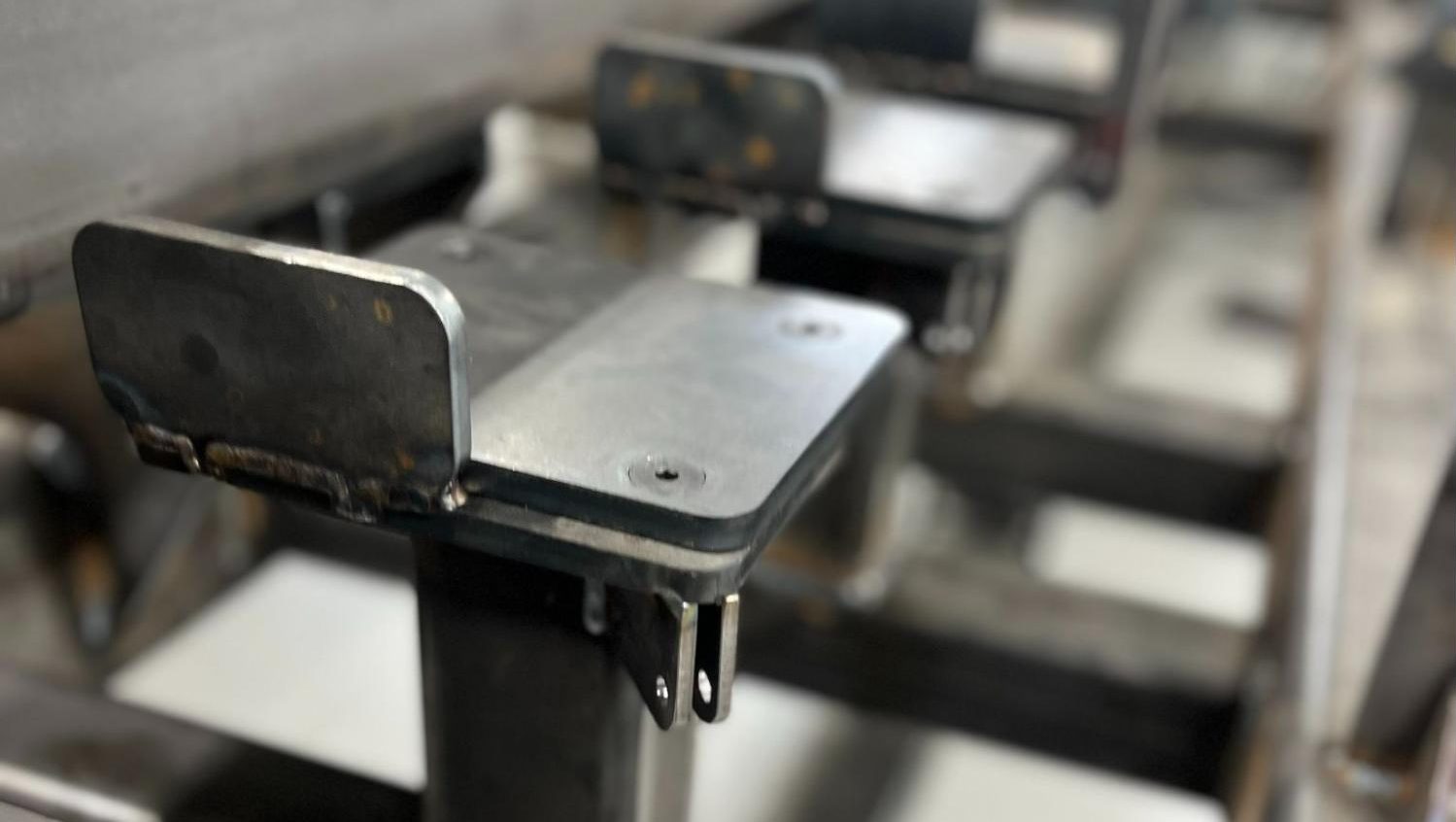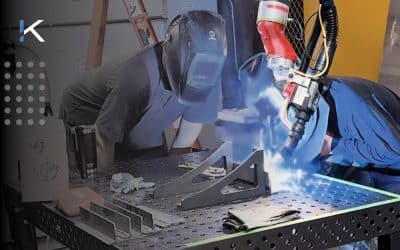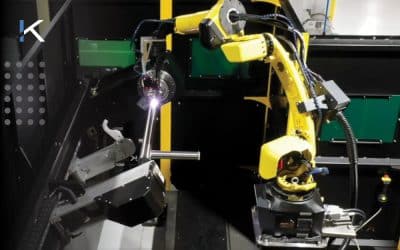At Kinetic Technologies, we know there’s no one-size-fits-all approach to excellent automation. Every shop’s processes, parts, and people present unique challenges, requirements, and capabilities. Before we design and build custom welding fixtures, we dig deep to thoroughly understand your company’s precise needs. This two-part series will outline everything you should know about obtaining custom welding fixtures from Kinetic.
10 Questions that Empower Exceptional Welding Fixtures
With your answers to 10 key questions, we can begin the detailed work of crafting a custom cobot welding fixture that does the work you want—the way you want it.
1. What’s your primary objective for your fixture?
Every customer has their own reasons for commissioning a custom welding fixture. Identify your main goal, and we’ll prioritize solutions to match.
- Quality. Consistent quality is a major concern for many Kinetic customers. Maybe you’re having issues with measurements, or your current fixture is causing surface damage to your parts. We develop welding fixtures that resolve any number of quality concerns; just tell us what you need!
- Ergonomics. We tackled one outdated setup where thermal expansion made our customer’s parts nearly impossible to remove from the fixture. The problem was so severe that our customer kept a sledgehammer on hand simply to beat the parts out of the fixture after welding! Ergonomic issues can make for funny stories, but in truth, they’re serious problems that need to be corrected. That’s what we’re here for!
- Safety. Some parts are simply dangerous without the proper fixturing. Maybe they’re extremely heavy or off-center, or perhaps they have plunger stops that can cut fingers (or worse)! In other cases, the original welding fixtures themselves pose a safety risk. Regardless of the cause, Kinetic can devise a resolution.
- Speed. One of the most common reasons our customers obtain custom welding fixtures is to speed up production. Kinetic develops fixtures that can cut a company’s production time by a factor of 10! To obtain such high levels of productivity, we work directly with your manufacturing specialists and welders to develop a deep understanding of your welding process. With total comprehension of your welding sequence, the Kinetic team is equipped to incorporate the most important elements, suggest improvements, and eliminate any cumbersome processes that create bottlenecks and increase costs.
- Process flow. Our team needs to understand your entire facility flow so we can develop a practical fixture for your purposes. After all, there’s no advantage to dramatically increasing your welding potential if you can’t increase your parts production to match! Once we’ve assessed your process control outline all the way through to material flows, we’ll have a better idea of how your business can benefit from a custom fixture or cobot integration.
2. How consistent are your upstream parts?
Manual layouts are typically quite forgiving, but welding fixtures must be designed specifically for your actual upstream process. If your parts often vary by 16”, for example, that factor influences our fixturing design. With accurate information, we can develop your fixture to accommodate any inconsistencies.
3. Do you have CAD data for your parts?
It’s not all that uncommon for a manufacturer to work primarily from paper drawings. If you don’t have any CAD data or 3D models of your assemblies, we’re happy to reverse engineer and create 3D models of your parts. CAD data gives us the dimensional details required to accurately customize your cobot welding fixture.
4. What welding process do you use?
Different fixturing requirements apply to different welding processes. Are you MIG welding? TIG welding? Is a robot doing the work? Then, of course, there are numerous process versions to consider: globular spray, CV spray, pulse, mag CMT, short circuit, and more. A fixture tailored for a single process may not support a different process should you make changes later on, so we want to know all the ways you intend to utilize your fixture before getting started.
5. What are your weld callouts?
It’s important for us to know any weld specifications and callouts, like bead length and width. One current Kinetic customer employs an internal weld inspection process that exceeds most AWS standards! This level of particularity ensures exceptional part quality, but it also demands welding fixtures advanced enough to accommodate the processes necessary for achieving critical weld callouts. For instance, if the weld callouts require multi-pass welding, the robot and the fixture must work in tandem to provide the best quality weld.
6. What is your part’s purpose?
Parts requiring watertight or extremely strong welds necessitate highly specialized fixturing. For instance, one of our customers makes a part for off-road, safety-critical, industrial use, so their fixturing must adequately secure each part throughout a heavy-duty welding process intended to prevent cracking.
7. What welding positions do you use?
Some customers don’t have a preference; they can weld flat, vertical, uphill, and overhead. Others adhere to weld specifications that dictate a single welding orientation, meaning we may need to develop their welding fixtures with uniquely tailored positioners.
8. How do you ground your fixtures?
To facilitate a quality arc and a strong weld, the welding fixture must be appropriately grounded. We ensure reliable earth grounding by designing grounding points into the fixture—and let’s not forget the positioner! We learned the hard way how a positioner’s lifespan can be truncated by a poorly grounded fixture.
During the early stages of developing our RT1 cobot welding table, an arc shot through the ungrounded fixture and actually extracted the table’s nitride splatter resistance!
Corrosion points exist wherever arc flash emits from the base materials into the fixture. To protect against that corrosion, the fixture must be grounded through the table, directly on the part, or with strong contacts that connect directly to the bar.
Tell us your current grounding process if you have one; either way, we’ll make sure your fixture includes an easy grounding method so you don’t make the same mistake we made!
9. Can you benefit from automated clamping?
For customers seeking to scale a welding fixture’s productivity, we recommend incorporating automated clamping mechanisms into the fixture’s design. Equipping a fixture with auto-clamping does increase its upfront cost—sometimes significantly—but you’ll quickly recover your investment through gains in part volume and automation goals.
Kinetic’s automated clamps are designed to handle electromagnetic interference (EMI), arc current, corrosive gases, intense infrared light, heat, and flame. From design to delivery, we emphasize doing the work correctly the first time around to ensure uninterrupted quality and safety from every product, for every customer.
10. How many parts do you make?
The size of your average production run influences your fixture’s design. As you can imagine, a few hundred parts per month impacts a fixture’s longevity significantly less than several thousand parts per month! When we know your quantities, we can make informed decisions on clamping styles, materials, and other critical aspects of the fixture.
It Starts with You: The Future of Automation in Manufacturing
As manufacturers, we tend to discuss robotics and automation as distant concepts from a far-off future. But the truth is that “tomorrow’s” technological advancements are here now, and they’re currently revolutionizing our day-to-day work!
Kinetic’s 10 key questions may seem tedious and basic, but that’s because automation is not science fiction. It’s real, it’s complex, and when it’s done right, automation can radically improve your shop’s success!
Join the robotics revolution with a welding fixture built to suit your shop’s specialty services.
Talk to Kinetic Technologies to get started!>>> Learn even more about Kinetic’s approach to fixturing automation! Check back next month for Welding Fixtures Done Right, Part 2: Our 4-Step Design-and-Build Method.

Mark Barglof is the President and owner of Kinetic Technologies, LLC, a robotic welding integration shop just north of Algona, IA. After serving in the military and earning the U.S. Army Ranger Tab, Mark shifted career paths and dove into the world of manufacturing. His vision is to build a full-service engineering and robotics company that can bring to bear all the advanced engineering tools to support their clients and make their concepts come to life quickly. They are intently focused on robotic welding integrations, robotic welding positioners and fixtures, and custom machine building.




